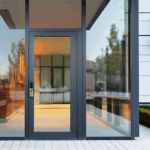Last year I wrote a couple of blog posts about tornado doors – one called Tornado Safety in Schools, which included articles and other information about tornadoes that had recently occurred in Oklahoma and Texas. The other post was Shelter from the Storm, which described changes to the 2015 International Building Code. The IBC now requires facilities in some areas of the country to have a storm shelter constructed in accordance with ICC 500 – ICC/NSSA Standard for the Design and Construction of Storm Shelters. This change will affect areas where the shelter design wind speed for tornadoes is 250 MPH – as shown in Figure 304.2(1) of ICC 500. The facility types impacted are Educational occupancies with an occupant load of 50 or more (except Group E day care facilities and Group E occupancies accessory to places of religious worship), as well as facilities used for critical emergency operations – 911 call stations, emergency operation centers and fire, rescue, ambulance and police stations.
When I wrote the blog posts I searched for a good video of the test that door openings must pass in order to meet the requirements of ICC 500, and last week I found one on the website of the Steel Door Institute (SDI):
There’s also a great article from SDI that was published in a recent issue of Doors & Hardware magazine. An excerpt appears below…you can click here to read the rest.
Code Change Is Coming
The International Building Code (IBC) 2015 requires that new school construction in areas susceptible to tornadoes with winds of 250 mph or higher must have storm shelters. Check out the map in ICC 500, and you will see that this zone ranges from Texas to Alabama up to New York.
Any new K-12 structure with the capacity to hold 50 or more people will be required to have shelter space to house the structure’s maximum occupancy. And it’s not only educational facilities that are affected by this change. Emergency operation centers, 911 call stations, and fire, rescue, ambulance and police stations are also included.
While some regions may wait years to adopt IBC 2015, others have already chosen to implement shelter construction requirements in advance of IBC 2015. Local codes could even require some existing facilities to be retrofitted with storm shelters.
Corey Schultz, an architect with Schultz Squared Architects in Wichita, Kan., is an expert on tornado shelters. When interviewed recently about the code change, Schultz said, “This is long overdue in my opinion. I realize that schools are having trouble with funding as it is, but you really can’t put a price on a child’s life. In recent years we’ve heard heartbreaking stories about schools hit by tornadoes, so I’m really glad this is being added to the code.”
Thank you to SDI for allowing me to share this information on my site.
You need to login or register to bookmark/favorite this content.






I would like to see the “tornado” door hit in the same spot again and see if it holds up. Hitting it adjacent to the hinge isn’t really demonstrative of anything other than shear strength from the hinge and screws, where I suspect the non-tornado door would have held up as well as the rated door.
The locations where the projectile hits the door, as well as the number of times, velocity, etc., are all determined by ICC 500.
I’d like to see the cannon shots hit the doors in the same spot.
This video is a misleading. As said above, all three doors should be tested at the same impact area. How far do we go with making our homes, schools and other building so storm resistant? We see here in FL many people are being pushed out of brick and mortar buildings/homes due to the cost due to code changes. Many are going to mobile homes and hope for the best. Maybe we could put more safety codes in place, if we did not have counties forcing builder to put in AC and garages.
A couple things about this video appear misleading and I would love some follow up. Notice in the standard door, that it is a traditional cylindrical lockset. The beveled edge of the latch bolt ALLOWS the door to swing inward once the impact folded the door and spread the frame. Note on the Tornado door that it is a mortise lockset that quite possibly could have a deadbolt thus giving it a significant amount of strength at the impact point.
To make an accurate comparison, the Tornado door needs to follow the exacts parameters as the control. Again, I would love to see some follow up video.